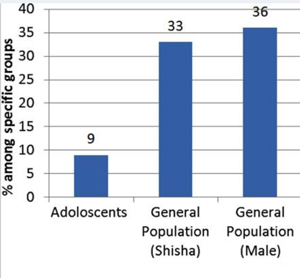Clinical study protocol on electronic cigarettes and nicotine pouches for smoking cessation in Pakistan: a randomized controlled trial
Pakistan is one of most vulnerable low- and middle-income countries with 29 million adult active tobacco users. Smoking cessation services are lacking as the tobacco control initiatives have largely failed to address the smoking endemic. Over the last 5 years, Pakistan has witnessed the use of innovative tobacco harm reduction (THR) products such as e-cigarettes and nicotine pouches. However, their use remains limited. THR products are imported legally as consumer goods and are taxable. The lack of sufficient data for THR and its application is a challenge in gauging their effectiveness in assisting smokers quit combustible smoking. Evidence-based studies can help in measuring the effectiveness of e-cigarettes and nicotine pouches as smoking cessation aids.
Exenatide as an adjunct to nicotine patch for smoking cessation and prevention of postcessation weight gain among treatment-seeking smokers with pre-diabetes and/or overweight: study protocol for a randomised, placebo-controlled clinical trial
Introduction: Obesity and smoking are the two leading causes of preventable death in the USA. Unfortunately, most smokers gain weight after quitting. Postcessation weight gain (PCWG) is frequently cited as one of the primary barriers to a quit attempt and a common cause of relapse. Further, excessive PCWG may contribute to the onset or progression of metabolic conditions, such as hyperglycaemia and obesity.
Evaluation of the Effect of Electronic Cigarette Devices/Vape on the Color of Dental Ceramics: An In Vitro Investigation
The use of vaping or electronic cigarette devices (ECDs) has recently increased as an alternative to conventional tobacco smoking products. By recording the CIELAB coordinates (L*a*b*) and computing the total color difference values using a spectrophotometer, the effect of ECDs on contemporary aesthetic dental ceramics was investigated in this in-vitro study.
The Snuffbox: The Effect of Smokeless Tobacco Use on Scaphoid Fracture Healing
Smoking has been demonstrated to be a risk factor for nonunion of scaphoid fractures, but it is unclear if chewing tobacco confers similar risk. The purpose of this study was to evaluate rates of bone-related complications after nonsurgical management of scaphoid fractures in smokeless tobacco users compared with matched control subjects and compared with smokers.
Thromboembolism Triggered by a Combination of Electronic Cigarettes and Oral Contraceptives: A Case Report and Review of Literature
Genetic predisposition, oral contraceptive (OCP) use, tobacco smoking, cancers, and trauma are well-known triggers for hypercoagulability and thromboembolism. Multiple reports have been published on the health risk of combining OCP and traditional cigarettes smoking in the context of thromboembolism. However, limited information is available on the health consequences of combining OCP use with electronic cigarettes.
The impact of e-cigarette exposure on different organ systems: A review of recent evidence and future perspectives
The use of electronic cigarettes (e-cigs) is rapidly increasing worldwide and is promoted as a smoking cessation tool. The impact of traditional cigs on human health has been well-defined in both animal and human studies. In contrast, little is known about the adverse effects of e-cigs exposure on human health.
A randomized, controlled study to assess changes in biomarkers of exposures among adults who smoke who switch to oral nicotine pouch products relative to continuing smoking or stopping all tobacco use
The purpose of this open-label, randomized, controlled, in-clinic, five parallel-group study was to assess biomarkers of exposure (BoEs) to select harmful and potentially harmful constituents (HPHCs) in adults who smoke (AS; N = 144 switching to oral tobacco products (on!® mint nicotine pouches; Test Products) compared to continuing smoking cigarettes (CS) and completely quitting all tobacco products (NT).
Nicotine Treatment Ameliorates Blood-Brain Barrier Damage After Acute Ischemic Stroke by Regulating Endothelial Scaffolding Protein Pdlim5
Analysis of a National Institutes of Health (NIH) trial shows that cigarette smoking protected tissue plasminogen activator (tPA)-treated patients from hemorrhage transformation (HT); however, the underlying mechanism is not clear. Damage to the integrity of the blood-brain barrier (BBB) is the pathological basis of HT.
Research
Reports
Featured Posts
A Randomized Controlled Trial Evaluating the Efficacy of E-Cigarette Use for Smoking Cessation in the General Population: E3 Trial Design

Efficacy and safety of electronic cigarettes as a smoking cessation intervention: A systematic review and network meta-analysis



